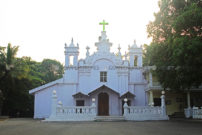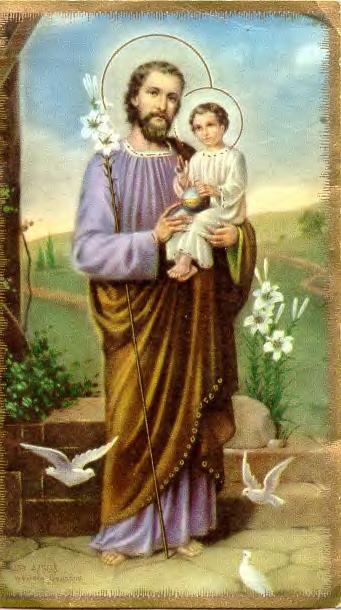
St. Joseph

St. Joseph (Hebrew יוֹסֵף, Yosef; Greek: Ἰωσήφ, Ioseph) is a figure in the Gospels, the husband of the Blessed Virgin Mary, the mother of Jesus, and is venerated as St. Joseph in the Catholic Church, Eastern Orthodox Church, Oriental Orthodox Church, Anglican Communion, Lutheranism and Methodism. Christian tradition places Joseph as Jesus‘ foster father.
The Pauline epistles make no reference to Jesus’s father; nor does the Gospel of Mark. The first appearance of Joseph is in the gospels of Matthew and Luke. Each contains a genealogy of Jesus showing ancestry from king David, but through different sons; Matthew follows the major royal line from Solomon, while Luke traces another line back to Nathan, another son of David and Bathsheba. Consequently, all the names between David and Joseph are different. According to Matthew 1:16 “Jacob begat Joseph the husband of Mary”, while according to Luke 3:23, Joseph is said to be “[the son] of Heli“. Some scholars[who?] reconcile the genealogies by viewing the Solomonic lineage in Matthew as Joseph’s major royal line, and the Nathanic lineage in Luke to be Mary’s minor line.
In Catholic and other traditions, Joseph is the patron saint of workers and has several feast days. He was also declared to be the patron saint and protector of the Catholic Church by Pope Pius IX in 1870, and is the patron of several countries and regions. With the growth of Mariology, the theological field of Josephology has also grown and since the 1950s centers for studying it have been formed.
The epistles of Paul are generally regarded as the oldest extant Christian writings. These mention Jesus’s mother (without naming her), but do not refer to his father. The Book of Mark, the first gospel to be written with a date about two decades after Paul, also does not mention Jesus’s father. Joseph first appears in the Gospels of Matthew and Luke, both dating from around 80-90 AD. The issue of reconciling the two accounts has been the subject of debate.
Like the two differing genealogies, the infancy narratives appear only in Matthew and Luke, and take different approaches to reconciling the requirement that the Messiah be born in Bethlehem with the tradition that Jesus came from Nazareth. In Matthew, Joseph obeys the direction of an angel to marry Mary. Following the birth of Jesus in Bethlehem, Joseph and family stay in Bethlehem for an unspecified period (perhaps two years) until after the visit of the Three Magi, when Joseph is told by an angel in a dream to take the family to Egypt to escape the massacre of the children of Bethlehem planned by Herod the Great, who rules Judea. Once Herod has died, an angel tells him to return, but to avoid Herod’s son he takes his wife and the child to Nazareth in Galilee and settles there. Thus in Matthew, the infant Jesus, like Moses, is in peril from a cruel king, like Moses he has a (fore)father named Joseph who goes down to Egypt, like the Old Testament Joseph this Joseph has a father named Jacob, and both Josephs receive important dreams foretelling their future.
In Luke, St. Joseph already lives in Nazareth, and Jesus is born in Bethlehem because Joseph and Mary have to travel there to be counted in a census. Subsequently, Jesus was born there. Luke’s account makes no mention of angels and dreams, the Massacre of the Innocents, or of a visit to Egypt.
The last time St. Joseph appears in person in any Gospel is the story of the Passover visit to the Temple in Jerusalem when Jesus is 12 years old, found only in Luke. No mention is made of him thereafter. The story emphasises Jesus’s awareness of his coming mission: here Jesus speaks to his parents (both of them) of “my father,” meaning God, but they fail to understand.(Luke 2:41-51).
Christian tradition represents Mary as a widow during the adult ministry of her son. St. Joseph is not mentioned as being present at the Wedding at Cana at the beginning of Jesus’s mission, nor at the Passion at the end. If he had been present at the Crucifixion, he would under Jewish custom have been expected to take charge of Jesus’s body, but this role is instead performed by Joseph of Arimathea. Nor would Jesus have entrusted his mother to the care of John the Apostle if her husband was alive.
While none of the Gospels mentions St. Joseph as present at any event during Jesus’s adult ministry, the synoptic Gospels share a scene in which the people of Nazareth, Jesus’s hometown, doubt Jesus’s status as a prophet because they know his family. In Mark 6:3, they call Jesus “Mary’s son” instead of naming his father. In Matthew, the townspeople call Jesus “the carpenter’s son,” again without naming his father. (Matthew 13:53-55) In Luke 3:23 “And Jesus himself began to be about thirty years of age, being (as was supposed) the son of Joseph, which was [the son] of Heli.”(Luke 4:16-30) In Luke the tone is positive, whereas in Mark and Matthew it is disparaging.[16] This incident does not appear at all in John, but in a parallel story the disbelieving neighbors refer to “Jesus the son of Joseph, whose father and mother we know” (John 6:41-51).
St. Joseph is mentioned only in the gospels of Matthew and Luke. Since both these draw their narrative of Jesus’ life from Mark, which offers no information on Jesus’ parentage, they must both have taken their versions of the Joseph from some other source.
Joseph as the father of Jesus appears in Luke and in a “variant reading in Matthew”. Matthew and Luke both contain a genealogy of Jesus showing ancestry from king David, but through different sons; Matthew follows the major royal line from Solomon, while Luke traces another line back to Nathan, another son of David and Bathsheba. Consequently, all the names between David and Joseph are different. According to Matthew 1:16 “Jacob begat Joseph the husband of Mary”, while according to Luke 3:23, Joseph is said to be “the son of Heli“. Some scholars reconcile the genealogies by viewing the Solomonic lineage in Matthew as Joseph’s major royal line, and the Nathanic lineage in Luke to be Mary’s minor line.
The gospels describe Joseph as a “tekton” (τέκτων). Tekton has been traditionally translated into English as “carpenter”, but is a rather general word (from the same root that gives us “technical” and “technology”) that could cover makers of objects in various materials. The Greek term evokes an artisan with wood in general, or an artisan in iron or stone.But the specific association with woodworking is a constant in Early Christian tradition; Justin Martyr (died c. 165) wrote that Jesus made yokes and ploughs, and there are similar early references.
John Dominic Crossan puts tekton into a historical context more resembling an itinerant worker than an established artisan, emphasizing his marginality in a population in which a landowning peasant could become quite prosperous. Other scholars have argued that tekton could equally mean a highly skilled craftsman in wood or the more prestigious metal, perhaps running a workshop with several employees, and noted sources recording the shortage of skilled artisans at the time. Geza Vermes has stated that the terms ‘carpenter’ and ‘son of a carpenter’ are used in the Jewish Talmud to signify a very learned man, and he suggests that a description of Joseph as ‘naggar’ (a carpenter) could indicate that he was considered wise and highly literate in the Torah.
At the time of Joseph, Nazareth was an obscure village in Galilee, about 65 kilometres (40 mi) from the Holy City of Jerusalem, which is barely mentioned in surviving non-Christian texts and documents. Archaeology over most of the site is made impossible by subsequent building, but from what has been excavated and tombs in the area around the village, it is estimated that the population was at most about 400. It was, however, only about 6 kilometres from the city of Tzippori (ancient “Sepphoris”), which was destroyed by the Romans in 4 BC, and thereafter was expensively rebuilt. Analysis of the landscape and other evidence suggest that in Joseph’s lifetime Nazareth was “oriented towards” the nearby city, which had an overwhelmingly Jewish population although with many signs of Hellenization, and historians have speculated that Joseph and later Jesus too might have traveled daily to work on the rebuilding. Specifically the large theatre in the city has been suggested, although this has aroused much controversy over dating and other issues. Other scholars see Joseph and Jesus as the general village craftsmen, working in wood, stone and metal on a wide variety of jobs.
March 19, Saint Joseph’s Day, has been the principal feast day of Saint Joseph in Western Christianity[54][55] since the 10th century, and is celebrated by Catholics, Anglicans, many Lutherans and other denominations.[56] In Eastern Orthodoxy, the feast day of Saint Joseph is celebrated on the First Sunday after the Nativity of Christ. In the Roman Catholic church, the Feast of St. Joseph (19 March) is a Solemnity (first class if using the Tridentine calendar), and is transferred to another date if impeded (i.e., 19 March falling on Sunday or in Holy Week).
In 1870, Pope Pius IX declared Joseph patron of the universal Church and instituted another feast, with an octave, to be held in his honour on Wednesday in the second week after Easter. This was abolished by Pope Pius XII, when in 1955 he established the Feast of “St. Joseph the Worker”, to be celebrated on 1 May. This date counteracts May Day (International Workers’ Day), a union, workers’, and socialists’ holiday commemorating the Haymarket affair in Chicago, and reflects Joseph’s status as what many Catholics and other Christians consider the “patron of workers” and “model of workers.” Catholic and other Christian teachings and stories about or relating to Joseph and the Holy Family frequently stress his patience, persistence, courage, and hard work.
The Feast of St. Joseph the Worker (1 May) is an Optional Memorial, and so is omitted if impeded, unless the day is raised to a higher rank because St. Joseph is the patron of the church, diocese, place, or institution. (However, the 1 May celebration is 1st class in the Tridentine calendar, so in it St. Joseph the Worker was celebrated on 2 May in 2008 because 1 May was Ascension Thursday and in 2011 because 1 May was in the Easter octave.)
Pope Pius IX proclaimed Saint Joseph the patron of the Universal Church in 1870. Having died in the “arms of Jesus and Mary” according to Catholic tradition, he is considered the model of the pious believer who receives grace at the moment of death, in other words, the patron of a happy death.
Saint Joseph is the patron saint of a number of cities, regions and countries, among them the Americas, Canada, China, Croatia, Mexico, Korea, Austria, Belgium, Peru, the Philippines and Vietnam, as well as of families, fathers, expectant mothers (pregnant women), travelers, immigrants, house sellers and buyers, craftsmen, engineers, and working people in general.